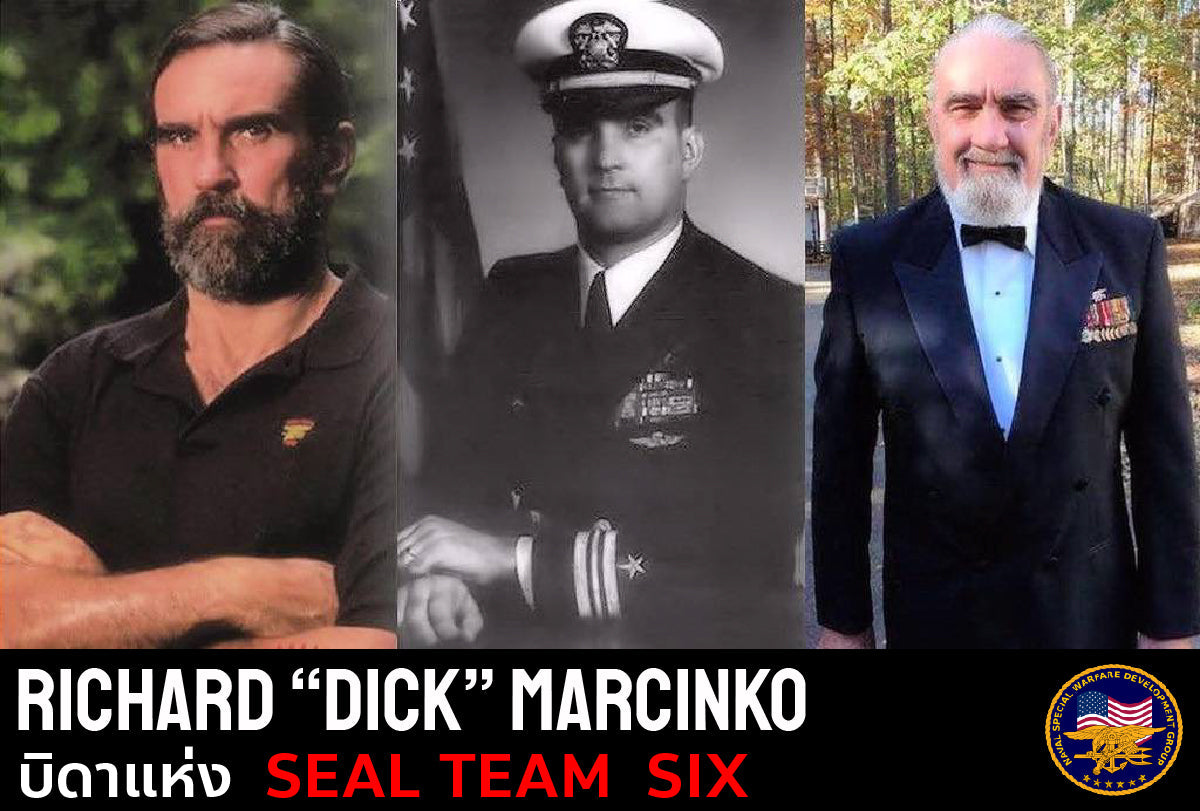Richard "Dick" Marcinko, the father of SEAL TEAM SIX
Marcinko was born on November 21, 1940, in Lansford, Pennsylvania. He is of Slovak descent, as his parents were from Slovakia. When he was young, his family moved to New Brunswick, New Jersey.
After dropping out of high school in New Brunswick, New Jersey, Marcinko attempted to enlist in the United States Marine Corps but was rejected due to his lack of completion of high school. Marcinko was successfully drafted into the United States Navy in September 1958 as a radio operator. Marcinko completed the 26th Underwater Demolition Team/Replacement (UDTR) course in October 1961. He served with UDT-21 until being selected for commission in 1965. After graduating from Officer Candidate School in December 1965, his first rank was ensign and he was later assigned to SEAL Team TWO in June 1966.
Vietnam War

In January 1967, Marcinko was sent to Vietnam with the 2nd Platoon of SEAL Team Two. His first tour lasted six months. On May 18, 1967, Marcinko led his men in an attack on the Viet Cong island of Ilo Ilo Hon, killing many Viet Cong and destroying six of their junks. The operation was considered by the U.S. Navy to be "the most successful SEAL operation in the Mekong Delta". Marcinko received the first of four Bronze Stars, the Vietnam Cross of Gallantry, and the Silver Star for the mission, and a bounty of 50,000 piasters (French Indochinese currency) was placed on his head by the North Vietnamese.
Shortly after completing his first tour, Marcinko returned to Vietnam with SEAL Team Two. From December 1967 to June 1968, during the Tet Offensive, Marcinko led his platoon in support of U.S. Army Special Operations Forces in the Battle of Chau Doc. What began as a street fight in the city turned into a hostage rescue mission to rescue eight American nurses and USAID personnel trapped in the city's church and hospital.
After completing his second tour in Vietnam and serving with the same unit for about two years, Marcingo was promoted to lieutenant commander and served 18 months as naval attaché to Cambodia in 1973. After his tour of duty, Marcingo returned to the United States and assumed command of SEAL Team Two from 1974 to 1976.
SEAL Team Six (DEVGRU)

During the 1979 Iran Hostage Crisis, Marcingo was one of two Navy representatives on the Joint Chiefs of Staff for the Terrorist Action Team (TAT ) task force. The task force was tasked with planning the rescue of American hostages held in Iran, known as Operation Eagle Claw. The operation resulted in the loss of eight U.S. personnel and several aircraft. As a result of the failure, the U.S. Navy recognized the need for a dedicated counter-terrorist team to handle such incidents, and assigned Marcingo to design and develop it.
Marcinko was selected by Navy Chief of Staff Admiral Thomas B. Hayward to be the first commander of the new unit. At the time, the Navy already had two SEAL teams, Teams One and Teams Two. Marcinko named his new unit SEAL Team Six to confuse other nations, especially the Soviet Union. Marcinko personally selected the unit's members from all U.S. Navy SEAL teams and Underwater Demolition Teams (UDTs), as well as SEAL Team Two's counterterrorism unit, codenamed MOB-6.
Marcingo intended to establish SEAL Team Six as the Navy's elite counter-terrorism unit, similar to the Army's Delta Force. He served as commander of SEAL Team Six for three years, from August 1980 to July 1983 (normally, it would be only two years).
Red Cell

After handing over command of SEAL Team Six, Marcingo was reassigned by Vice Admiral James "Ace" Lyons, the Deputy Chief of Naval Operations, to create a team to test security vulnerabilities in various U.S. Navy bases. Known as OP-O6D, or Red Cell, the team consisted of 14 personnel, including 13 former SEAL Team Six members and one Force Recon, and was led by Marcingo.
Red Cells often use fake codes to infiltrate naval bases, take hostages, and kidnap high-ranking personnel. In one instance, Red Cells managed to plant a bomb near Air Force One or even sneak into a submarine base and capture it. All of Red Cell's operations are recorded and reported to the base's top officials, who then point out weaknesses and problems that need to be addressed. However, many see Red Cell's operations as an affront to them, and Marcingo is later charged with various crimes, including embezzlement, dismissal, and disbandment.
However, the Red Cell was re-established by the CIA after the 9/11 attacks to brainstorm ideas from various sectors to develop measures to counter international terrorism.
After his discharge, Marcinko wrote the New York Times best-selling autobiography Rogue Warrior and has written several other novels. He is also the CEO of Red Cell International and SOS Temps Inc., a private security consulting firm in Washington, D.C. He has a political radio talk show, “America on Watch with Dick Marcinko,” is the spokesman for the Zodiac Maritime Training Academy, and serves as a consultant on the FOX television series 24. He briefly collaborated with Strider Knives on the design of the “Rogue Warrior” knife.
Richard "Dick" Marcinko passed away on December 25, 2021. Throughout his time in the U.S. Navy, Marcinko played an integral part in SEAL history, leaving behind a unique legacy. “Demo Dick” was America's premier counter-terrorism operator. Our deepest sympathies go out to his family, teammates, and friends.
Source
https://www.navytimes.com/breaking-news/2021/12/26/richard-marcinko-first-commanding-officer-of-seal-team-six-dies/
https://en.wikipedia.org/wiki/Richard_Marcinko


